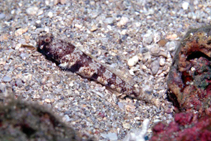| Family: |
Gobiidae (Gobies), subfamily: Gobiinae |
| Max. size: |
3.15 cm SL (male/unsexed) |
| Environment: |
benthopelagic; marine; depth range 7 - 25 m |
| Distribution: |
North Atlantic Ocean: São Tomé Island. |
| Diagnosis: |
Body moderately elongate and laterally compressed, head moderately depressed; interorbital space very narrow, dorsolaterally positioned eyes. Mouth strongly oblique, lower jaw slightly projecting, posterior angle of jaws below mideye. Snout shorter than eye and rounded in dorsal view. Anterior nostril tubular (longer than diameter), without process from rim, barely reaching but not overlapping the upper lip; posterior nostril slightly erected, but not tubular. Chin lacking barbels. Upper lips anteriorly slightly thinner than laterally. Branchiostegal membrane attached along entire lateral margin; gill opening approximately at the level of lower edge of pectoral fin base. Cranial roof covered by dorsal axial musculature. Pectoral girdle without dermal flaps on anterior edge. Tongue truncate (Ref. 79573). |
| Biology: |
It was observed that only single specimens were found at the entrance of burrows of the axiid shrimp Axiopsis serratifrons; in depths from 7 m to 25 m (P. Wirtz, pers.comm. in Ref. 79573). Stomach contents visible on the radiograph of the holotype show at least 6 snails
of different families: one of Sinozona sp. (Scissurellidae), and several which most likely
belong to Rissoidae and Limacinidae (Schwabe, pers.comm. In Ref. 79573). |
| IUCN Red List Status: |
Vulnerable (VU); Date assessed: 09 March 2015 (B2ab(iii)) Ref. (130435)
|
| Threat to humans: |
harmless |
Source and more info: www.fishbase.org. For personal, classroom, and other internal use only. Not for publication.
